Gujarat is a land of different shades and hues. Gujarati wedding rituals, in tune with the soul of people of the land, are also very colourful. People of Gujarat, a proud ethnic race, have achieved modernity that is an inseparable part of affluence that they have attained through the sweat of their brows. But instead of turning iconoclastic, they are to this day dearly upholding their various customs and traditions.
Let’s embark on the journey that Gujaratis go through when they have a wedding in the family.
Pre-Wedding Rituals
Chandlo Matli
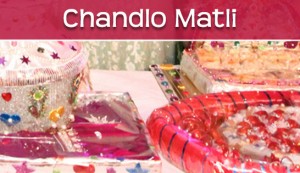
Chandlo marks the commencement of the marriage alliance. In this ceremony, the father of the bride along with four close male relatives of his family visits the home of the groom and marks his forehead with red vermilion. A circle is usually drawn at the center of the forehead which signifies the third eye or awakening of his spiritual conscience. The father of the bride also gives a gift or token money, also called
The father of the bride also gives a gift or token money, also called shagun to the groom. Traditionally, this is also the ceremony where the wedding dates are formally finalized, creating a strong, unbreakable bond between not just the engaged couple but also their families.
Sagaai or Gol Dhana
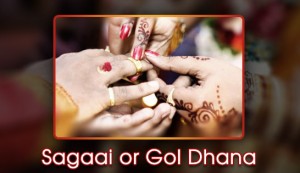
This is the Gujarati engagement/ring ceremony. It is held at the house of the groom and the close family members from both sides are invited. The bride and her family arrive with savouries and other gifts for the groom and his family in a container called matli.
The would-be couple exchanges rings, formally accepting each other as their future partners. Often the Chandlo Matli and the Sagaai happen on the same day. The elders, especially married women bless the couple one by one, wishing them connubial harmony. The name Gol Dhana or Gor Dana comes from the fact that coriander seeds and jaggery are distributed during the sagaai.
Mehendi/ Sangeet Sandhya or Sanji/Garba
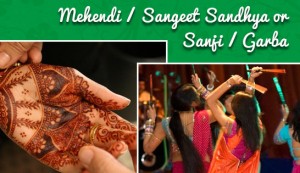
This is an informal ceremony which takes place two or three days before the day of the wedding. It is a ceremony of mirth and lighthearted banter. Mehendi, henna dye is applied on the hands and feet of the bride and other ladies of the house. Mehendi is considered auspicious and an inextricable part of any Indian wedding ritual.
This is followed by singing and dancing (the traditional Garba or Dandiya Raas), all through the evening till late night and ladies crack jokes and try to make the bride loosen up. A similar ceremony resembling a bachelor’ party also takes place at the residence of the groom.
Pithi
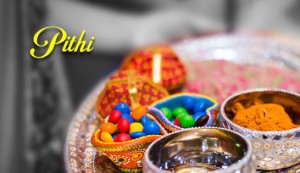
This ritual is usually held a day or two before the wedding. Pithi is a mixture of crushed turmeric, sandalwood powder, herbs, rosewater, and perfumes. This mixture is primarily prepared by the paternal aunty of the bride/groom. It is put on a decorated platter and taken to the priest who blesses it.
The mixture is then applied to the body of the bride/groom a day or two prior to the wedding and also on the morning of the wedding. It is believed to enhance the glow or the radiance of the body of the bride or the groom.
Mameru or Mosaalu
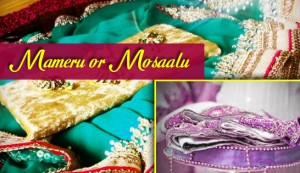
This is a ceremony in the Gujarati wedding rituals where the maternal uncle or the mama of the bride presents her gifts for her wedding. Usually, the saree or lehenga she would wear during the marriage ceremony, ivory bangles or chooda and other jewellery are bestowed on the bride. The bride touches the feet of her mama and
The bride touches the feet of her mama and mami and asks for their blessings. Mameru or Mosaalu, generally take place a day before the wedding.
Mandap Mahurat and Grah Shanti
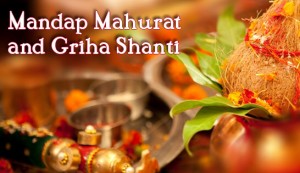
A puja seeking the benediction of Lord Ganesh and other Gods is performed before setting up the Mandap where the wedding rituals would take place. The designated spot is covered with a canopy.
Immediately following this ceremony, Grah Shanti puja is also performed. This is a Puja performed to invoke the blessings of the nine planets, asking for a favorable union of the two families, peace in the house and a trouble-free marriage. Grah Shanti puja is performed at the houses of bride as well as the groom.
Gujarati Wedding Rituals
Baraat or Varghoda and Ponkhana
The groom leaves his home with his baraat or wedding procession. Before leaving the home, the groom’s sister would wave a bag full of coins over his head, partly to ward off any evil attack and partly to remind him of his duties to her as the brother even after his marriage.
The groom then sets off on a caparisoned mare towards the wedding venue with his friends and relatives in tow. They usually follow on a motorcade or walk, depending on the distance.
They dance and make merry. This is known as Baraat or Varghoda.
By the time the groom alights from his mare, the family of the bride is already waiting at the entrance to receive and greet him. The bride’s mother then does mangal aarti of the groom and puts a tilak on his forehead. The rest of the guests are also welcomed with aarti.
Ponkhana is the ritual where the mother of the bride holds the nose of the groom playfully to remind him that it is he who has come to their home to ask for the hand of her daughter and he must make every effort to keep her daughter in good humor and comfort always. The groom also bows before his would-be mother-in-law to express his gratitude and humility. He is then lead inside. His path is strewn with earthen pots which he has to crush with his feet signifying his ability to overcome obstacles.
Jaimala or Varmala
After entering the premise, the groom is greeted by the bride and they exchange garlands. This is known as Jaimala. To make the proceedings funny, the bride and the groom are lifted by their friends on their shoulders and they compete to lift them more than the other group and make it difficult for the bride/groom to exchange the garlands.
Kanya Agaman and Antarpat
After Jaimala, the bride retires to her private chamber while the groom is led to the mandap where he waits for the bride. A veil or curtain called Antarpat, is then raised around the mandap.
Meanwhile, the bride makes her way towards the mandap, escorted by her maternal uncle. As the wedding rituals proceed, the curtain separating the bride and the groom is slowly lowered. The ceremony is called kanya agaman.
Madhuparka
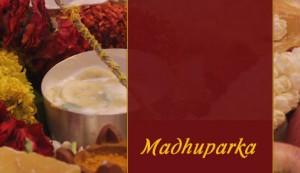
As the groom is considered an incarnation of Lord Vishnu or Narayana, the groom is invited to the mandap by his future mother-in-law and his feet are washed and dried by his future father-in-law.
After this, the groom is offered a special drink called Panchamrut which translates to the nectar of 5 ingredients. The ingredients are milk, sugar, ghee, yogurt, and honey. Following this ritual, the sisters and the female friends of the bride remove (steal) the shoes of the groom which he had taken off before entering the mandap.
To get back his shoes, the groom tries to negotiate the “ransom” amount and only when both sides agree on an amount, the shoe is returned. There is a lot of fun interaction and negotiation during this event.
Kanya Daan
This is a ritual where the parents of the bride hand her over to the groom. They put the left hand of the bride in the right hand of the groom. This signifies that from now on the groom makes a formal commitment to take care of all the needs of the bride, which were heretofore the concern of her parents.
The groom is considered a human form of Lord Vishnu and the bride, his earthly consort, an avatar of Goddess Lakshmi. The bride sits on the left of the groom and the wedding rituals are performed in front of the pious wedding fire that is ignited to solemnize the wedding.
Hasta Milap
After the Kanyadaan, the scarf or the end of the dhoti of the groom is tied to one end of the saree of the bride and the would-be couple also hold the hands of each other. This signifies the union of two souls, body and mind.
The priest chants mantras and shlokas and implores the blessings of Lord Vishnu and Devi Lakshmi and Lord Shiva and Devi Parvati and prays for an unbreakable conjugal bond between the couple. The assembled guests also come forward to bless the couple and sprinkle grains of rice, sometimes with their husks intact and flowers on them.
Mangal Pheras
In Gujarati weddings, the bride and the groom go around the sacred fire, completing four rounds with the pyre in the center. Each such round is called a mangal phera and with each round the groom chants mantras along with the priest to entreat his bride to give him her loving support throughout their married life. Hindus believe that our life is built on the four pillars of dharma, artha, kama and moksha and each phera represents one such pillar.
Saptapadi
This is a very important ritual. When you are talking about a Hindu wedding, the first thing that crosses your mind is probably saptapadi and this ritual has become the leitmotif of marriages depicted in Indian movies also. The groom is followed by the bride as they complete seven rounds around the sacred fire and take seven unbreakable marriage vows with each round.
The exclusivity of this ritual in a Gujarati wedding is that after completing each round, the couple stops and the bride touches seven betel nuts with her right toe before embarking on another round. Through these mantras, the groom seeks the support of his wife.
Saubhagyavati Bhava
This is a typical Gujarati wedding ritual in which seven married women from the bride’s side move around the couple and whisper blessings and good wishes in the right ear of the bride. This ritual is called saubhagyavati bhava, where they wish for the good luck, happiness and prosperity of the couple.
Aashirvad
After the completion of all the wedding rituals and the couple have been declared married, they touch the feet of their elders and ask for their blessings. The elders also oblige and pray for their overall happiness. This marks the end of the wedding ceremony.
Chero Pakaryo
This is also an amusing ritual in the Gujarati weddings. Following the completion of wedding rituals, when the mother-in-law of the groom passes by him, he tugs at the end of her saree motioning her to give him some gifts. He is then given some token gifts which he cherishes.
Post-Wedding Rituals
Vidaai
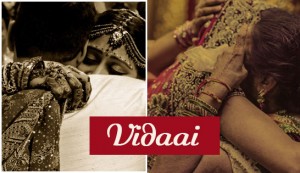
After the wedding, it is time for the wedded couple to leave. The groom returns back to his home with his newly-wed wife. It is a very emotional and tear-jerking moment when the bride bids farewell to her family and relatives who have brought her up and asks for their permission to leave. There are tears of joy and sadness, all at the same time. Usually, the brothers of the bride escort her out of the home and the couples leave in a bedecked car or a horse-drawn carriage.
Gharni Laxmi
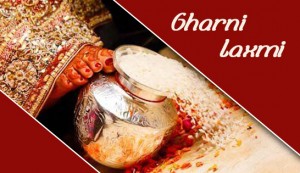
A welcome ceremony is organized at the ‘new home’ of the newly-wed wife. Married ladies including the mother-in-law and sisters of the groom welcome her. The bride is treated as Goddess Lakshmi, the Goddess of wealth and it is believed that the bride would bring in good fortune and lots of wealth into her new family.
The mother-in-law places a vessel or a pot full of rice which the bride has to upturn by touching with her feet. Red lac dye is applied to her feet and the imprint is taken on a white cloth which is then bound in a frame. The bride accepts her responsibilities towards her new family.
Aeki Beki
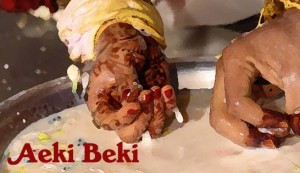
After the welcome, the couple is sat and made to play a fun game. It is known as Aeki Beki. A vessel full of water is kept in front of them. Milk and vermillion is then dissolved into the water-filled vessel. Several coins and a ring are put into the vessel. Now the bride and the groom try to find the ring.
The game is repeated seven times and it is a common belief that of the two, whoever would find it four out of seven times, would reign over the house i.e. that person would be more authoritative.
The day comes to an end with a prayer to ask for the long and healthy life of the couple, marital bliss, everlasting love and prosperity. After this, the couple retires for the night to their private suite and consummates their marriage.
As I have mentioned at the beginning of this post, Gujarati weddings are full of colour, life, and endless gaiety. They are simple yet full of pomp and grandeur. This longstanding institution binds together many different generations of the same family. It is a joyous occasion which gives an opportunity to all the members of the extended family to meet, taking time off from their busy schedules.
A complex wedding requires thorough planning. People used to plan with diaries and Excel sheets. But now there is a better option.
WedPlan wedding planning software takes care of the logistics planning part which would give you enough time to deal with the creative aspects of the wedding as well as spend more time with your guests and family. Try out the no-obligation and FREE demo if the software developed by the awesome software development team of Ebizindia and experience the convenience of efficient end-to-end planning and management!